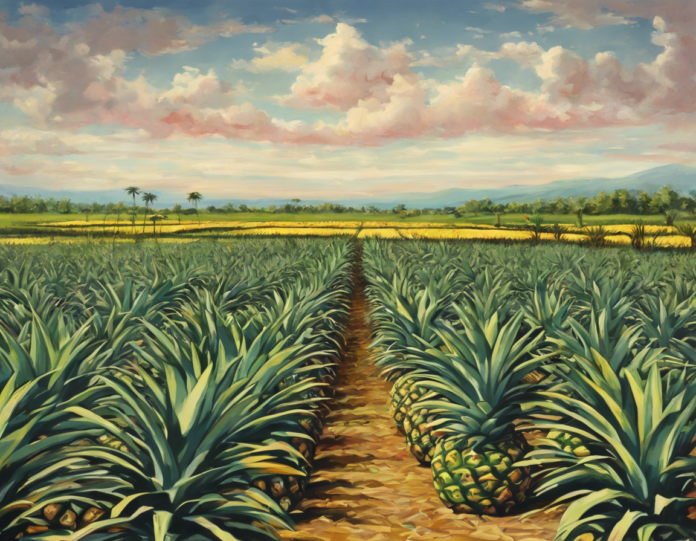The pineapple is a tropical fruit loved for its sweet and tangy flavor, but have you ever wondered about the vibrant fields where these fruits are grown? Pineapple fields are not just a sight to behold but also a significant part of the agricultural industry in many tropical regions. Let’s dive into the world of pineapple fields and explore the beauty and complexity of these vast plantations.
The Origin of Pineapples
Pineapples, scientifically known as Ananas comosus, are native to South America, particularly in regions like Paraguay, Brazil, and Argentina. They were later spread by the indigenous people throughout Central America, the Caribbean, and other tropical regions. Today, countries like Costa Rica, the Philippines, Thailand, and Indonesia are major producers of pineapples.
Cultivation of Pineapples
Pineapples are typically grown in tropical climates with rich, well-draining soils. The cultivation process starts with planting the crown or the top portion of a ripe pineapple fruit. This crown is planted in the soil where it takes root and starts to grow into a new plant. It takes about 18-24 months for a pineapple plant to reach maturity and produce fruit.
Pineapple Varieties
There are various varieties of pineapples, each with its own unique taste, size, and appearance. Some popular varieties include the Smooth Cayenne, Queen Victoria, Red Spanish, and Sugar Loaf. The Smooth Cayenne variety, known for its large size and juicy flesh, is one of the most commonly grown types worldwide.
Characteristics of Pineapple Fields
Pineapple fields are a mesmerizing sight, with rows upon rows of spiky green leaves stretching out as far as the eye can see. The plants typically have a rosette of sword-like leaves that can grow up to 3-5 feet in length. As the fruit develops, it forms at the center of the rosette and can take several months to reach maturity.
The Harvesting Process
Pineapples are harvested by hand when they are fully ripe. A skilled worker can harvest around 60-80 pineapples per hour. After harvesting, the pineapples are cleaned, sorted based on size and quality, and packed for transportation to markets around the world. The timing of the harvest is crucial as pineapples do not continue to ripen after they are picked.
Sustainable Practices in Pineapple Farming
Many pineapple farmers are adopting sustainable practices to reduce their environmental impact and ensure the long-term viability of their crops. These practices include crop rotation, organic farming methods, water conservation, and integrated pest management. By implementing these techniques, farmers can reduce the use of chemicals, conserve natural resources, and protect the biodiversity of the surrounding ecosystem.
Challenges Faced by Pineapple Farmers
Pineapple farming comes with its own set of challenges. Pests and diseases can affect the plants, leading to reduced yields and quality of fruit. Additionally, fluctuations in weather patterns, such as excessive rainfall or drought, can impact the growth of the plants. Ensuring a stable market price for their produce is another challenge that farmers often face.
Pineapples in Popular Culture
Pineapples have made their way into popular culture in various forms. From being a symbol of hospitality and welcome to featuring prominently in culinary dishes, cocktails, and even fashion trends, the pineapple has a unique charm that captivates people around the world. Its distinctive appearance and refreshing taste make it a favorite fruit for many.
Exploring Pineapple Fields
Visiting a pineapple plantation can be a memorable experience for travelers. Many tropical destinations offer guided tours of pineapple fields where visitors can learn about the cultivation process, taste freshly harvested pineapple, and even try their hand at picking the fruit. It’s a great way to immerse yourself in the tropical beauty of these lush fields and appreciate the hard work that goes into growing this iconic fruit.
Frequently Asked Questions (FAQs)
What is the best time of year to visit a pineapple field?
The peak season for visiting pineapple fields varies depending on the location, but generally, spring and summer months offer the best weather and ripest fruit for visitors to enjoy.
How long does it take for a pineapple to grow?
It takes approximately 18-24 months for a pineapple plant to reach maturity and produce fruit.
Are pineapples grown all year round?
Yes, pineapples can be grown year-round in tropical climates where the conditions are suitable for their cultivation.
How do you know when a pineapple is ripe and ready to harvest?
A ripe pineapple will have a sweet fragrance at the base, a golden color on the bottom, and the leaves at the crown will be easy to pluck.
Can you grow a pineapple plant at home?
Yes, you can grow a pineapple plant at home by planting the crown of a ripe pineapple in a pot with well-draining soil and providing adequate sunlight and water.
How many pineapple varieties are there?
There are over 100 varieties of pineapples, each with its unique characteristics and flavor profiles.
What are some common pests that affect pineapple plants?
Common pests that can affect pineapple plants include aphids, mealybugs, thrips, and mites.
How long do pineapple plants live?
Pineapple plants can live for up to 50 years in the right conditions, producing fruit for several seasons during their lifetime.
What is the nutritional value of pineapples?
Pineapples are rich in vitamin C, manganese, and antioxidants. They are low in calories and high in fiber, making them a healthy addition to your diet.
How are pineapples transported from the fields to markets?
Pineapples are typically harvested, cleaned, sorted, and packed into crates for transportation. They are then shipped by land, sea, or air to markets around the world.












